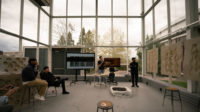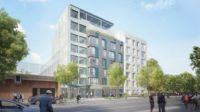Climate Activists Maneuver To Reduce Embodied Carbon in Buildings

Climate activists engage in complicated maneuvers to reduce embodied carbon in buildings
There was no formal agenda on February 12, 2018, when Bruce King and William Kelley met for lunch at the Lotus Cafe in San Rafael, California. But building regulation is a favorite topic of King’s, a structural engineer devoted to reducing carbon emissions related to buildings. So it was no surprise to Kelley, Marin County’s deputy director for building and safety, that King suggested it would “be nice” to craft a low-carbon concrete building code “to rein in the profligate overuse” of carbon-intensive cement in concrete.
Kelley liked the idea of regulating concrete’s embodied carbon (EC)—the greenhouse gases (GHGs) emitted during production. But funding was needed to support the writing of a code for low-EC concrete.
Two weeks later, King happened to be at a meeting of an ad hoc group trying to rebuild sustainably after California’s devastating 2017 wine-country fires. There, he heard an announcement that the Bay Area Air Quality Management District would soon offer grants for novel methods of addressing GHGs. He alerted Kelley. Soon, Marin County applied for a BAAQMD grant, which it received on Oct. 4, 2018.
The funds, a maximum of $206,456, set the wheels in motion for developing the model Bay Area Low-Carbon Concrete Code. If approved by Marin County’s board of supervisors on Nov. 19, the code, unprecedented in the U.S. because it would limit EC in private—not just public—projects, would be the first of its kind in the nation.
Kelley likes the Bay Area model code because it is simple to use for customers, plan checkers and enforcers. The document, only four pages long, has two sets of compliance pathways for plain and reinforced concrete: 1) limit cement in either the mix or the project; or 2) limit the global warming potential either of a concrete mix—based on an approved environmental product declaration—or a project, taking into account all the mix designs.
If adopted, the code would apply only to unincorporated Marin County, population 60,000. That doesn’t bother King. “We hope it will be the code heard around the world,” says the founder of the 20-year-old Ecological Building Network.
Read this full story on ENR.com.



